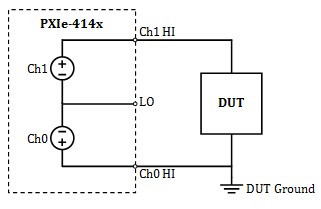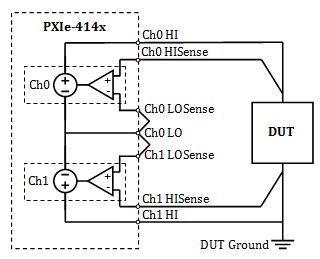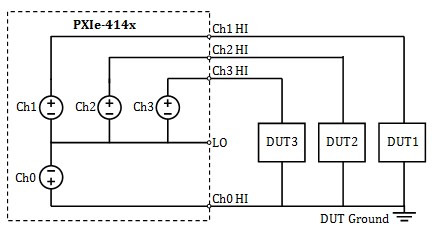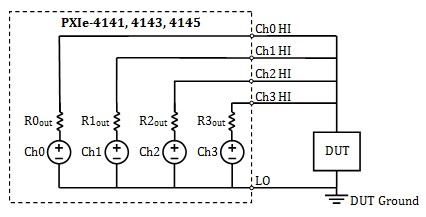Cascading the Outputs of the NI PXIe-414X
Overview
Contents
- The NI PXIe-414x Family
- Constant Voltage Mode: Series Cascading for Higher Output Voltage
- Constant Current Function: Series Cascading for Higher Voltage Compliance
- Constant Current Mode: Parallel Cascading for Higher Output Current
- Constant Voltage Function: Parallel Cascading for Higher Current Compliance
The NI PXIe-414x Family
NI offers a variety of SMUs for different applications. The table below provides the maximum current and maximum voltage specifications for the different modules.
| Module | Max Current (ADCmax) | Max Voltage (VDCmax) |
| PXIe-4140/4141 | ±100 mA | ±10 V |
| PXIe-4142/4143 | ±150 mA | ±24 V |
| PXIe-4144/4145 | ±500 mA | ±6 V |
| PXIe-4147 | ± 3 A | ± 8 V |
Table 1
Constant Voltage Mode: Series Cascading for Higher Output Voltage
The 4 channels on the modules in the NI PXIe-414x family are bank-isolated and share a common LO connection. Because of this architecture, multiple channels cannot be connected in series by connecting the HI of one channel to the LO of another. However, output voltages of up to twice the maximum voltage (2VDCmax) of a single channel can be achieved by connecting two channels in series as shown in the following schematic:
Figure 1
To achieve +2VDCmax across the DUT per the schematic in Figure 1, Ch1 must be programmed for +VDCmax in constant voltage mode and Ch0 must be programmed for -VDCmax in constant voltage mode. Likewise, to achieve -2VDCmax across the DUT per the schematic in Figure 1, Ch1 must be programmed for -VDCmax in constant voltage mode and Ch0 must be programmed for +VDCmax in constant voltage mode. In either case, it is recommended that the current compliance limit be programmed to the same value for both Ch0 and Ch1. Additionally, the current through Ch0 and Ch1 must not exceed ADCmax. LO for Ch0 and Ch1 is connected internally on the device and should be left floating when using local sense. Do not connect LO to the DUT Ground. When using remote sense as shown in Figure 2, the LO sense terminals of Ch0 and Ch1 should be connected to a single LO terminal (the LO terminal of either Ch0 or Ch1 will suffice).
Figure 2
Expansion of the schematic in Figure 1 to create two bipolar ±2VDCmax channels is not recommended. However, the schematic in Figure 1 can be expanded to create up to three positive unipolar channels with a maximum +2VDCmax output or up to three negative unipolar channels with a maximum -2VDCmax output, as shown in the following schematic:
Figure 3
When the NI PXIe-414x is configured as shown in Figure 3, there are a few things to consider:
For three positive-polarity channels:
- The DUTs connected to the HI terminals of Channels 1-3 must share a common ground connection.
- Channel 0 must be programmed with a voltage of -VDCmax in constant voltage mode.
- To source +2VDCmax between ChX (where X is in the range of 1-3) and DUT Ground, ChX must be programmed with a voltage of +VDCmax in constant voltage mode. To source 0VDC between ChX and DUT Ground, ChX must be programmed with a voltage of -VDCmax in constant voltage mode.
- The current through Ch0 must not exceed ADCmax, meaning that the sum of the currents through Ch1-3 must not exceed ADCmax.
For three negative-polarity channels:
- The DUTs connected to the HI terminals of Channels 1-3 must share a common ground connection.
- Channel 0 must be programmed with a voltage of +VDCmax in constant voltage mode.
- To source -2VDCmax between ChX (where X is in the range of 1-3) and DUT Ground, ChX must be programmed with a voltage of -VDCmax in constant voltage mode. To source 0VDC between ChX and DUT Ground, ChX must be programmed with a voltage of +VDCmax in constant voltage mode.
- The current through Ch0 must not exceed ADCmax, meaning that the sum of the currents through Ch1-3 must not exceed ADCmax.
When using remote sense for multiple unipolar series connected channels, the LO sense terminals of all channels should be connected to a single LO terminal (the LO terminal of any channel will suffice).
Constant Current Function: Series Cascading for Higher Voltage Compliance
Multiple channels of the PXIe-414x can also be cascaded in series for a higher voltage compliance limit when they are operated in constant current mode.
To achieve a voltage compliance limit of up to +2VDCmax in constant current mode per the schematic in Figure 1, Ch0 and Ch1 must each be programmed with a voltage compliance limit of +VDCmax in constant current mode. The current through Ch0 and Ch1 must not exceed ADCmax, and LO for Ch0 and Ch1 is connected internally on the device and should be left floating. Do not connect LO to the DUT Ground. When using remote sense as shown in Figure 2, the LO sense terminals of Ch0 and Ch1 should be connected to a single LO terminal (the LO terminal of either Ch0 or Ch1 will suffice).
The schematic in Figure 1 can be expanded to create up to three constant current mode channels with voltage compliance limits of up to +2VDCmax, as shown in Figure 3. When the NI PXIe-414x is configured as shown in Figure 3, there are a few things to consider:
- The DUTs connected to the HI terminals of Channels 1-3 must share a common ground connection.
- Channel 0 must be programmed with a voltage compliance limit of +VDCmax in constant current mode.
- To achieve a voltage compliance limit of up to +2VDCmax in constant current mode with the series combination of Ch0 and ChX (where X is in the range of 1-3), ChX must be programmed with a voltage compliance limit of +VDCmax in constant current mode.
- The current through Ch0 must not exceed ADCmax, meaning that the sum of the currents through Ch1-3 must not exceed ADCmax.
Constant Current Mode: Parallel Cascading for Higher Output Current
Channels of the NI PXIe-414x can be connected in parallel to produce output currents of up to 4ADCmax as shown in the following schematic:
Figure 4
When all channels are configured as shown in Figure 4, they must be operated at the same voltage compliance limit. If the voltage of all channels remains below the programmed voltage compliance limit, one channel should not attempt to control another. However, if any of the connected channels reach voltage compliance while operating in this mode, minor variations in the circuitry among all channels prevent their voltage levels from being identical. These minor variations could cause one channel to attempt to control another, resulting in undesired behavior or mismatch among the current supplied by the channels.
To prevent undesired behavior if operating near the voltage compliance limit, a small resistance can be added in series with each channel output, forcing the current to be shared evenly among the channels. In Figure 4 these series resistors are represented by R0-R3. For most applications, 0.5Ω-1Ω in series with each channel output should be adequate.
When using local sense, the cabling resistance can in many cases provide enough series resistance. However, when using remote sense the series resistance must be placed after the sense point, as shown in Figure 5. Wiring in this manner prevents the resistance from being overcome by the four-wire connection, but this configuration is only useful if the value of the series resistance is known. The presence of the series resistance, represented in Figure 5 by R0 for Ch0 and R1 for Ch1, will cause a voltage measurement error. This voltage measurement error can be accounted for in software by using the series resistance value to calculate a corrected voltage measurement.
Figure 5
Constant Voltage Function: Parallel Cascading for Higher Current Compliance
Multiple channels of the PXIe-414x can also be connected in parallel for a higher current compliance limit when they are operated in constant voltage mode, as shown in the schematic in Figure 4. However, minor variations in the circuitry among all channels in use prevent their voltage levels from being identical. These minor variations could cause one channel to attempt to control another, resulting in undesired behavior or mismatch among the current supplied by the channels.
To prevent undesired behavior, a small resistance can be added in series with each channel output as shown in Figure 4, forcing the current to be shared evenly among the channels. In general, 0.5Ω-1Ω in series with each channel output is adequate. When using local sense, the cabling resistance can in many cases provide enough series resistance. However, when using remote sense the series resistance must be placed after the sense point, as shown in Figure 5. Wiring in this manner prevents the resistance from being overcome by the four-wire connection, but this configuration is only useful if the value of the series resistance is known. The presence of the series resistance, represented in Figure 5 by R0 for Ch0 and R1 for Ch1, will cause a voltage setpoint error. This voltage setpoint error can be accounted for in software by using the series resistance value to calculate and program a corrected voltage setpoint.
For the PXIe-4141, PXIe-4143, and the PXIe-4145, adding a small resistance in series with each channel can be substituted by instead programming each channel with a small amount of output resistance (0.5Ω-1Ω is adequate for this method as well), as shown in Figure 6. Refer the NI DC Power Supplies and SMUs Help for more information about the Programmable Output Resistance function.
Figure 6





